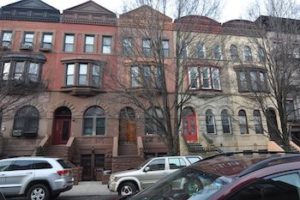
White-Rose-Mission-from-1918-to-1984 (center)
*On this date, 1897, the White Rose Home for Colored Working Girls was founded.
Also known as the White Rose Mission and the White Rose Industrial Association, it was created as a "Christian, nonsectarian Home for Colored Girls and Women" by black civic leaders Victoria Earle Matthews and Maritcha Remond Lyons. The settlement house in Manhattan's Upper Westside neighborhood, known then as San Juan Hill, was founded to offer refuge, shelter, and food for newly arrived black women from the southern United States and the West Indies.
Aware of the perilous conditions for young black women seeking work in New York City, Matthews, Lyons, and other volunteers working with The White Rose Mission met incoming vessels. Volunteers offered assistance at Manhattan’s piers, docks, and railway stations to female travelers who often fell prey to unscrupulous employment agents and con artists. A former slave, Matthews was a prominent social reformer. She conducted detailed research into the working conditions of young black women, often bypassing a white person to obtain information on schemes and organized rings. Matthews observed that for "the young and unfriended (women) of other races, there are all sorts of institutions," but for black girls and women, "there is nothing."
She, Lyons, and poet and activist Alice Moore Dunbar Nelson organized a dedicated group that shared her commitment. Black migrants coming to New York City during Reconstruction faced limited employment opportunities, inadequate housing, grinding poverty, racial prejudice, and racially motivated violence. Founded to offer shelter and food to destitute migrants, The White Rose Mission also offered job placement for the new arrivals. As black workers were relegated to jobs as unskilled laborers, conditions and opportunities for black female workers in New York City were deplorable. The aim of the employment placement service of the White Rose Mission was to furnish skilled, circumspect domestic workers to middle-class homes.
The Mission also offered instruction in housekeeping, such as cooking, sewing, expert waiting, and laundering. Additionally, The Mission provided a clean parlor where women who were dues-paying members could entertain callers. The White Rose Mission evolved to deliver social services unavailable to blacks in New York City, such as enrichment classes, child-rearing instructions, and a Penny Provident Bank thrift program.
The White Rose Mission also maintained a library of works relevant to the history and accomplishments of African and African American people. Considered one of the most unusual and important early collections of special materials about Black people, the library included a 1773 edition of Phillis Wheatley's poems, an 1859 volume of the Anglo-African Magazine, and Lydia Maria Child's first edition of An Appeal in Favor of that Class of Americans Called Africans.
Lectures were regularly held at the Mission, and in 1908 "New Negro Movement" founder Hubert Harrison, a writer, orator, educator, critic, and political activist, offered race history classes, helped to organize a literary club at the White Rose Home, delivered lectures on post-war Reconstruction and took charge of the Home’s Boys Club. When it first opened in 1897, The White Rose Mission was located at 217 East 86th Street. In 1918, The Mission moved to 262 West 136th Street from where it operated until it ceased operation in 1984.